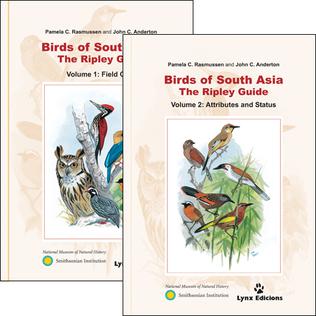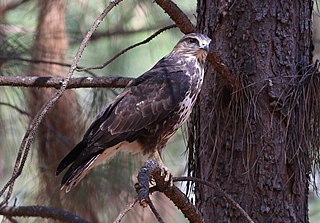
The common buzzard is a medium-to-large bird of prey which has a large range. It is a member of the genus Buteo in the family Accipitridae. The species lives in most of Europe and extends its breeding range across much of the Palearctic as far as northwestern China, far western Siberia and northwestern Mongolia. Over much of its range, it is a year-round resident. However, buzzards from the colder parts of the Northern Hemisphere as well as those that breed in the eastern part of their range typically migrate south for the northern winter, many journeying as far as South Africa.

Buteo is a genus of medium to fairly large, wide-ranging raptors with a robust body and broad wings. In the Old World, members of this genus are called "buzzards", but "hawk" is used in the New World. As both terms are ambiguous, buteo is sometimes used instead, for example, by the Peregrine Fund.

The rough-legged buzzard (Europe) or rough-legged hawk is a medium-large bird of prey. It is found in arctic and subarctic regions of North America, Europe, and Asia during the breeding season, and migrates south for the winter. Historically, it was also known as "rough-legged falcon" in such works as John James Audubon's The Birds of America.

The Himalayan marmot is a marmot species that inhabits alpine grasslands throughout the Himalayas and on the Tibetan Plateau. It is IUCN Red Listed as Least Concern because of its wide range and possibly large population.

The long-billed hermit is a bird in the family Trochilidae, the hummingbirds. It is found from central Mexico south through Central America, Colombia and Ecuador into Peru.

The augur buzzard is a fairly large African bird of prey. This species is distinct in typical adult plumage for its blackish back, whitish underside and orange-red tail, while juvenile augur buzzards are generally rather brown in colour; however a dark morph is known, which causes the bird's entire body to become darker. This member of the Buteo genus is distributed in several parts of the central and southern Africa, normally being found from Ethiopia to southern Angola and central Namibia. It is resident and non-migratory throughout its range. This is a species of mountains, and adjacent savannah and grassland. This is a typical buteonine raptor, being a generalist predator which tends to prefer small mammals supplemented by reptiles and birds among various prey items.

The mountain buzzard is a bird of prey that lives in montane forests in East Africa, it and the forest buzzard of southern Africa were, until recently, considered to be a single species.

The grey-chinned hermit is a species of hummingbird in the family Trochilidae. It is found in Brazil, Colombia, Ecuador, Peru, and Venezuela.

The upland buzzard is a species of bird of prey in the family Accipitridae. The largest species of the Buteo genus, this buzzard lives in mountainous grassy and rocky areas in areas of Central Asia, northern South Asia and East Asia from Kazakhstan to Korea. The upland buzzard is migratory but typically covers a short distance apparently to avoid snow cover that may hamper prey capture. This species primarily subsists on small mammals but does not shun alternate prey from small to large birds and insects. This little known raptor has a large range, and though generally uncommon, it is not thought to be rare or declining as a species. As a result it is classified as least concern by the IUCN.

The Cuban nightjar, sometimes also Greater Antillean nightjar, is a species of nightjar in the family Caprimulgidae. It is endemic to Cuba.

The Hispaniolan nightjar is a nightjar species endemic to the Caribbean island of Hispaniola, which is shared by the Dominican Republic and Haiti.

The Colombian crake is a species of bird in the subfamily Rallinae of the rail, crake, and coot family Rallidae. It is found in Colombia, Ecuador, and Panama.

The Surucua trogon is a species of bird in the family Trogonidae, the quetzals and trogons. It is found in Argentina, Brazil, Paraguay, and Uruguay.

The Socotra buzzard is a medium to large bird of prey that is sometimes considered a subspecies of the widespread common buzzard. As its name implies, it is native to the island of Socotra, Yemen. Although it is listed as vulnerable in the IUCN Red List, its population is considered to be stable.

Birds of South Asia: The Ripley Guide by Pamela C. Rasmussen and John C. Anderton is a two-volume ornithological handbook, covering the birds of South Asia, published in 2005 by the Smithsonian Institution and Lynx Edicions. The geographical scope of the book covers India, Bangladesh, Pakistan, Sri Lanka, Nepal, Bhutan, Maldives, the Chagos Archipelago and Afghanistan. In total, 1508 species are covered. Two notable aspects of Birds of South Asia are its distribution evidence-base — the book's authors based their distributional information almost completely on museum specimens — and its taxonomic approach, involving a large number of species-level splits.
Buteo burmanicus may refer to two different species of bird in the genus Buteo:
The Cape Verde buzzard is a medium to large bird of prey that is sometimes considered a subspecies of the widespread common buzzard. As its name implies, it is native to Cape Verde. Some taxonomists consider it a distinct species.

The forest buzzard, is a species of bird of prey found in Africa, though some authorities have placed it as a subspecies of another species, the mountain buzzard, Buteo oreophilus. This is a resident breeding species in woodlands in southern and eastern South Africa.

The eastern buzzard or Japanese buzzard is a medium to large bird of prey that is sometimes considered a subspecies of the widespread common buzzard. Some scientists treated is as a distinct species starting in 2008, but others still treat it as either one or three subspecies. It is native to East Asia and some parts of Russia and South Asia, with some birds wintering in Southeast Asia. It is similar to the steppe buzzard. It is carnivorous.

The Alaska red-tailed hawk is a subspecies of red-tailed hawk that breeds from southeastern coastal Alaska to Haida Gwaii and Vancouver Island in British Columbia. Despite its northerly distribution, this is the second smallest of the red-tailed hawks. Only the Jamaican red-tailed hawk is smaller. Little is known about this subspecies compared to other subspecies of red-tailed hawk.
























